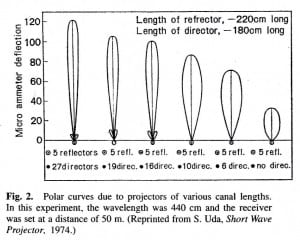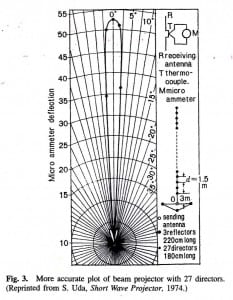SEPTEMBER 2011 HISTORY
Scanning the Past: A History of Electrical Engineering from the Past
Submitted by Marc Bell, Editor
Copyright 1997 IEEE. Reprinted with permission from the IEEE publication, “Scanning the Past” which covers a reprint of an article appearing in the Proceedings of the IEEE Vol. 85, No. 5, May 1997.
Shintaro Uda and the Wave Projector
Seventy years ago this month, the proceedings OF the institute of radio engineers (IRE) included a paper by Shintaro Uda (Fig. 1), a 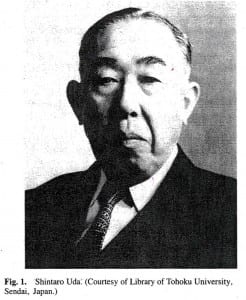 Japanese engineer, on the radiation of short waves. His paper included information on a recently invented antenna, which he called a wave projector but which later became known as the Yagi-Uda antenna. During his long career as a teacher and researcher at Tohoku University in Sendai, Japan, Uda made significant contributions to communications engineering.
Japanese engineer, on the radiation of short waves. His paper included information on a recently invented antenna, which he called a wave projector but which later became known as the Yagi-Uda antenna. During his long career as a teacher and researcher at Tohoku University in Sendai, Japan, Uda made significant contributions to communications engineering.
Uda was born in 1896 in Toyama Ken, Japan. He studied electrical engineering under H. Yagi at Tohoku University and graduated in 1924, and then joined a communications research group directed by Yagi. One of Uda’s first projects was to design a vacuum-tube oscillator that would operate at wavelengths of’around 440 cm. Experiments using the oscillator as a transmitter led to the discovery of the wave projector, Uda initially used a resonant loop antenna and observed the directive radiation it produced. He then tried placing a parasitic loop near the driven loop in an effort to obtain a more directive beam. The idea for this arrangement apparently was suggested by an earlier investigation of loops of various shapes conducted by one of his classmates as a thesis under Yagi’s direction. Subsequently, Uda substituted metal rods for parasitic loops and found that the field intensity in a preferred direction increased with the number of parasitic rods. He then undertook a systematic investigation to determine the effect on antenna directivity of changes in length, spacing, and geometric arrangement of parasitic elements (Figs. 2 and 3).
Yagi and Uda reported on the properties of the new antenna in a jointly authored paper entitled “Projector of the Sharpest Beam of Electric Waves” published in the Proceedings of the Imperial Academy of Japan in February 1926. Uda provided further information on the antenna in a long series of papers in the Journal of the IEE of Japan beginning in the March 1926 issue. Delegates from the United States and elsewhere learned about the wave projector and related research when Yagi and Uda presented a joint paper entitled “A New Electric Wave Projector and Radio Beacon” at the Third Pan-Pacific Science Congress held in Tokyo, Japan, in November 1926. This was soon followed by Uda’s IRE paper published in May 1927, in which he wrote that an array of parasitic director elements caused the directivity of a radiated beam to be “remarkably improved.” Prof. Yagi visited the United States in 1928 and gave a number of talks to engineering groups about work done by the Tohoku research team. He also published a paper in the proceedings OF the IRE in June 1928, in which he discussed both the wave projector and a split-anode magnetron developed by K. Okabe.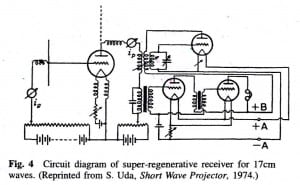
During 1929, Uda designed a regenerative shortwave receiver (Fig. 4) using a Barkhausen tube capable of reception down to about 40-cm wavelengths (Fig 5). He and his Tohoku colleagues used this receiver in conjunction with the wave projector antenna to demonstrate that communication was feasible at distances of up to 30 km at wavelengths below 1 m. Uda discussed these experiments in a second IRE paper published in June 1930 entitled “Radio-Telegraphy and Radiotelephony on Half-Meter Waves.” He went on to design a super-regenerative receiver that could be used for reception at 17 cm and reported on tests conducted at this wavelength at an IEE of Japan meeting in April 1931. The same year, he. Was awarded the doctorate degree in engineering by Tohoku University.
In 1954, Uda and Y. Mushiake jointly authored a book entitled The Yagi-Uda Antenna, which included theoretical work completed after World War II. The two men designed Yagi-Uda antennas suitable for use as television receiving antennas for the Yagi Antenna 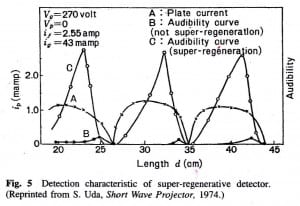 Company during the 1950’s. Uda also carried out microwave propagation research in India during 1955-1958. Other research after the war included work on millimeter traveling-wave tubes and lasers. Uda published Short Wave Projector: Historical Records of My Studies in Early Days in 1974. He died in 1976 at age 80. His mentor, Prof. Yagi, died earlier the same year at age 90.
Company during the 1950’s. Uda also carried out microwave propagation research in India during 1955-1958. Other research after the war included work on millimeter traveling-wave tubes and lasers. Uda published Short Wave Projector: Historical Records of My Studies in Early Days in 1974. He died in 1976 at age 80. His mentor, Prof. Yagi, died earlier the same year at age 90.
James E. Brittain

